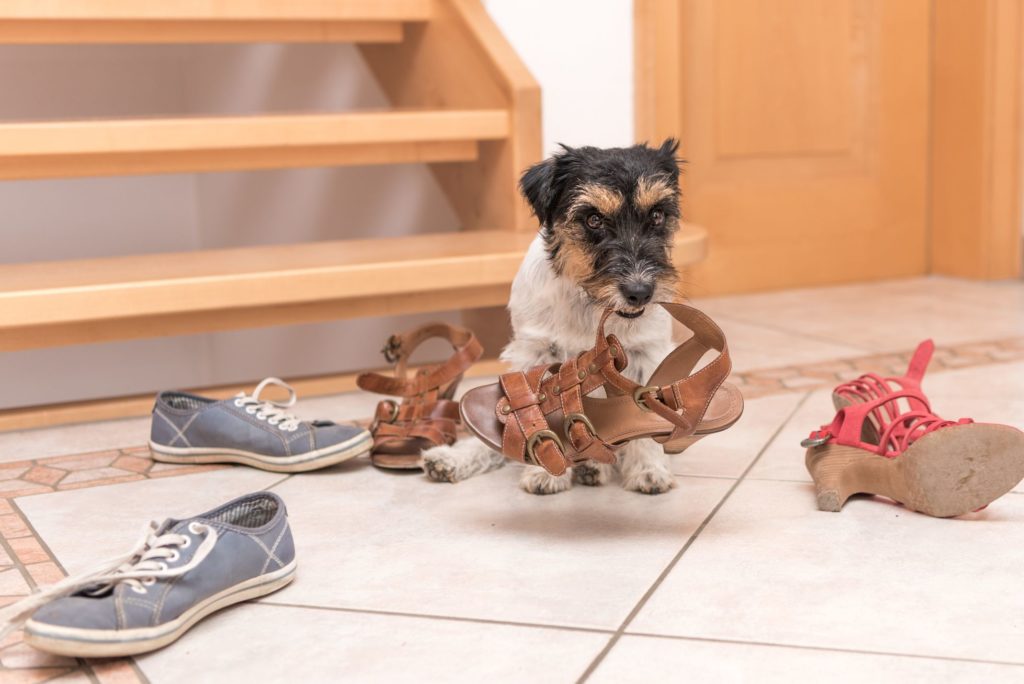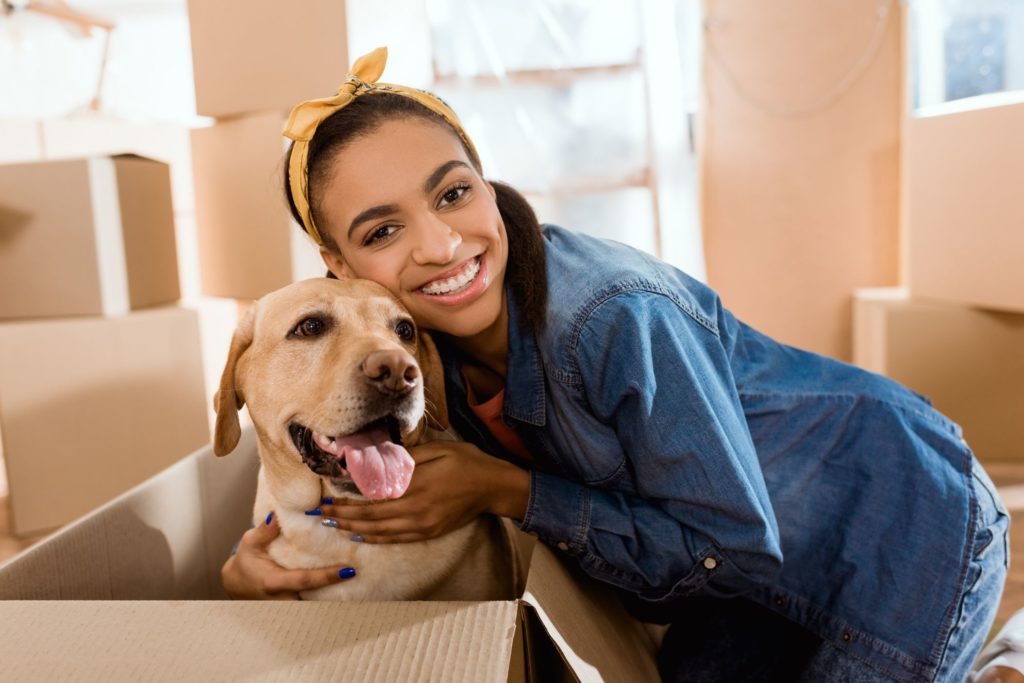Posted in
Moving Preparation, Moving Tips&Tricks
on December 8, 2021

Anastasia Hill
Apart from being the next fashion icon, Anastasia is also a freelance writer and expert on moving (and packing clothes).
4 Things You Should Know When Moving With a Dog
Consider yourself lucky if you’re moving with a dog – you’ll have your best friend beside you during this challenging period. Although relocating with your fluffy friends is usually a fun adventure, things can go wrong in no time. You have to be aware that this process affects them in a certain way. Rely on this guide to learn how to overcome all the obstacles and move safely with your doggo.
Do Dogs Do Ok With Moving?
One of the major things to consider when moving to another state in case that you’re relocating with pets is how this process is going to affect them. It is undeniable that this change will have a certain impact on everyone’s life – no matter if you’re a human or an animal. Your dog will need to adjust to some different routines, and this will take some time and patience.
Depending on your pet’s character, age and resiliency, the whole transition might go differently. For example, if your dog is older and has some issues with hips and climbing stairs, you better move to a building that has an elevator. In most cases, they’ll be fine with the transition as long as you know how to take good care of them during and after the move.
How Does a Move Affect a Dog? Signals That You Should Watch for When Moving Dog to a New Home
If you want to track your dog’s behavior during this period, it is highly recommended that you pay attention to even the smallest changes. Many different things can be a sign that your pet is experiencing certain stress and negative emotions. Some of the basic signs are walking around anxiously with their ears close to their head – like they are scared.
Their mouths can be tightly closed, and there’s often a certain grimace. It can also happen that they start to drool or tremble. Pay attention to the hair on their back – if it stands up, it can mean that your doggo is stressed. Some of the more significant signs of anxiety and panic are:
- Tucked tail,
- Hiding in corners or empty boxes,
- Trembling,
- Lower activity,
- Licking and biting,
- Drooling when there is no food around,
- Diarrhea,
- Withdrawal.
Is Moving Stressful for Dogs?
Animals can experience a certain level of stress when changing their living environment, so you should be considerate about their well-being. If you notice some of the above-mentioned symptoms or a combination of a few of them, that can be a serious indicator that your dog is having some difficulties and probably experiencing a certain amount of stress and anxiety. This is why you have to understand how to provide them comfort and security and prevent additional problems before developing. This can be very beneficial for your doggo so pay close attention to our essential tips.

Moving a dog to a new home can provoke certain reactions that you have to track carefully
#1 Pre-Move Visits to Your New Home Are Always Recommended – If Possible
Your pet thinks of your home as their safe place and a comfort zone – probably even more than you do, because that’s the only reality they know since they have spent the majority of their life there. If you brought them there when they were just little puppies, they probably know every corner of the house. Where everything seems familiar, they feel safe and sound. Relocating to a different home brings an enormous change to their usual routine, especially if they have never seen the place before.
This is why it is highly recommended that you visit this place with them at least once before the move and give them a chance to inspect their future territory. This might help them get familiar with the looks, scents, and sounds of your new home, and they will be able to leave their own scent as well. Once they move in, this can make the place feel less strange and scary.
Start Training Your Pets With Longer Car Drives and Help Them Prepare – Professional Movers Won’t Move a Dog or a Cat
If you’re planning long-distance moving and a visit before the relocation isn’t possible, you can find different ways to help them go through this transition easier. As long as you have enough reasons to move and decide that you’re not relocating to another state alone and plan to take your pets with you, it’s time to train them. If you only take them out for walks to the nearby local parks, they probably aren’t adjusted to longer car rides. If you plan a move to another city, you’ll have to drive your pets there on your own – animals are among the things movers won’t move, no matter if you’re relocating a fish, a dog, or a cat.
Remember – your furry friend feels better when you are around, especially if the ride to their new home is going to be a long one. This is why you have to train them to get used to rides – start with shorter ones and then gradually extend them until you see that your doggo is completely comfortable in the back of your car with no signs of motion sickness. Just ensure you make frequent stops and always provide them with some food as a treat and freshwater during training. This video might help you train your dog to ride in a car.
#2 You’ll Need a Lot of Patience for Your Pet
What’s one of the things you might forget to put on your relocating to another state checklist? Patience. It is normal that you experience various emotions during this process or even make some relocation mistakes, but try to give yourself and your dogs a break. Things can’t go completely perfect, no matter how well you plan every step in your relocation to-do list.
Just like people, animals need some time to adapt. Even the smallest change in their everyday routine and the only one they’re actually used to can feel like their whole life has changed. This is why they can get very sensitive during this process, and you have to be extra careful.
How Long Does It Take for a Dog to Adjust to a Move?
This depends on many factors – the age of your pet, their character, capabilities, and how familiar they are with the whole process. Are you relocating for the first time with them, or you’re frequently relocating, and they are already veterans? Did you get the chance to take them to your new house before the move and so on. The adjustment period can sometimes last for a few days or a few weeks. During that time, you have to be very patient, calm, and full of understanding.
They will need your attention in this period more than ever, so try to be with them as much as possible. If you are relocating for a job in a different city and have to start working right away, ask your neighbors to keep an eye on them, especially if you notice they are upset and bark once you leave the house. This is also a good way to make friends in a different city – especially if your neighbors are animal lovers like you. Once you get a chance, you can also walk them together and make a deeper connection.
Ensure You Pet Proof Your New Home
In the same way, you need to baby-proof house, if you are relocating with a newborn, you need to do a similar thing if you’re relocating with dogs. Once they overcome the fear of the unknown and start exploring their environment, they will probably try to smell or chew everything that gets in their way. This is why you have to ensure all the sharp objects, sockets, cords, and other potentially dangerous objects are covered or out of their reach.

You'll have to be patient and available as much as you can to prove your pet the much-needed comfort and protection
#3 Your Vet Can Give You Plenty of Useful Advice for the Big Day
Your current veterinarian’s office can share some good advice with you before the relocation day as well. Notify them that you’re relocating and possibly signing out of office, so they can help you go through this transition. Your vet probably knows your pets and how they react in certain stressful situations, so they can give you good advice when the relocation moment finally arrives. They can advise you about medication if needed and also assist you with transferring your pets’ files. They can also recommend some vets in the area you’re relocating to.

#4 Maintaining Their Routine Is Very Important
One of the most important things for animals is their routine – when it comes to sleeping, eating, and walking, your pet has its own rhythm and routine you are both adjusted to. If you used to feed or walk them in the morning before work, try to keep this routine the same once you decide where to live and relocate. If you enjoy taking your pet out and they love playing around pet-friendly parks, ensure that you have them close to your apartment – this is one of the most recommended house-hunting tips for pet owners.
Remember to Pack Their Essentials as Well
If you’re wondering what to get rid of and feel uncertain when deciding what to keep when relocating, you should know that your pet’s favorite toy should definitely be among your relocation essentials. No matter if their toys and bed are all chewed up and dirty, remember that they will provide them the smell and feeling of something familiar, which will lead to comfort even in the unknown environment.
This is why as much as you have an urge to buy everything new, still keep some of the good old favorites, at least for the adjustment period. Apart from having them in your apartment, you also want to have some of these objects in your essential boxes during the move – for the same reason.

If you want to know how to move with a dog without any difficulties, bringing some of their favorite toys is highly recommended
Moving With a Dog Doesn’t Have to Be Hard Now That You Know These Tips That Can Make the Process Easier
If you want to live on your own and taking your pet to another state with you is one of your priorities, we’re sure that these relocation hacks can help you guide them through this transition without any bigger problems. If you want to fully focus on your beloved animals and their well-being, you can always do yourself a favor and hire professional long-distance movers to take care of all other relocation-related responsibilities. With their convenient relocation services, we’re sure you’ll move efficiently in no time, and you’ll have plenty of energy left to take care of your pets.













